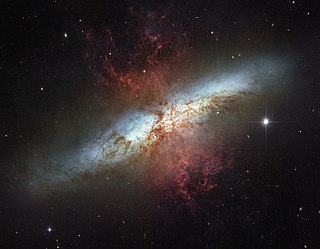
Messier 82 (also known as NGC 3034, Cigar Galaxy or M82) is a starburst galaxy approximately 12 million light-years away in the constellation Ursa Major. It is the second-largest member of the M81 Group, with the D25 isophotal diameter of 12.52 kiloparsecs (40,800 light-years). It is about five times more luminous than the Milky Way and its central region is about one hundred times more luminous. The starburst activity is thought to have been triggered by interaction with neighboring galaxy M81. As one of the closest starburst galaxies to Earth, M82 is the prototypical example of this galaxy type. SN 2014J, a type Ia supernova, was discovered in the galaxy on 21 January 2014. In 2014, in studying M82, scientists discovered the brightest pulsar yet known, designated M82 X-2.

IC 10 is an irregular galaxy in the constellation Cassiopeia. It was discovered by Lewis Swift in 1887 and in 1935 Nicholas Mayall became the first to suggest that the object is extragalactic. Edwin Hubble suspected it might belong to the Local Group of galaxies, but its status remained uncertain for decades. The radial velocity of IC 10 was measured in 1962, and it was found to be approaching the Milky Way at approximately 350 km/s, strengthening the evidence for its membership in the Local Group. Its membership in the group was finally confirmed in 1996 by direct measurements of its distance based on observations of Cepheids; most estimates place the galaxy 2–3 million light years from Earth, with some estimates ranging from 1.5–4.5 million light years. Despite its closeness, the galaxy is rather difficult to study because it lies near the plane of the Milky Way and is therefore heavily obscured by interstellar matter.

A starburst galaxy is one undergoing an exceptionally high rate of star formation, as compared to the long-term average rate of star formation in the galaxy, or the star formation rate observed in most other galaxies.
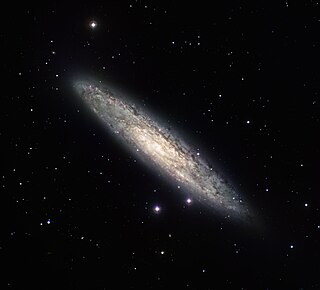
The Sculptor Galaxy is an intermediate spiral galaxy in the constellation Sculptor. The Sculptor Galaxy is a starburst galaxy, which means that it is currently undergoing a period of intense star formation.

The Antennae Galaxies are a pair of interacting galaxies in the constellation Corvus. They are currently going through a starburst phase, in which the collision of clouds of gas and dust, with entangled magnetic fields, causes rapid star formation. They were discovered by William Herschel in 1785.

NGC 1569 is a dwarf irregular galaxy in Camelopardalis. The galaxy is relatively nearby and consequently, the Hubble Space Telescope can easily resolve the stars within the galaxy. The distance to the galaxy was previously believed to be only 2.4 Mpc. However, in 2008 scientists studying images from Hubble calculated the galaxy's distance at nearly 11 million light-years away, about 4 million light-years farther than previously thought, meaning it is a member of the IC 342 group of galaxies.
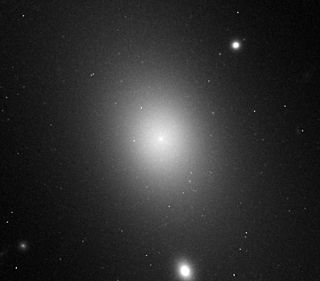
IC 1101 is a class S0 supergiant (cD) lenticular galaxy at the center of the Abell 2029 galaxy cluster. It has an isophotal diameter at about 123.65 to 169.61 kiloparsecs. It possesses a diffuse core which is the largest known core of any galaxy to date, and contains a supermassive black hole, one of the largest discovered. IC 1101 is located at 354.0 megaparsecs from Earth. It was discovered on 19 June 1790, by the British astronomer William Herschel.

Arp 220 is the result of a collision between two galaxies which are now in the process of merging. It is the 220th object in Halton Arp's Atlas of Peculiar Galaxies.
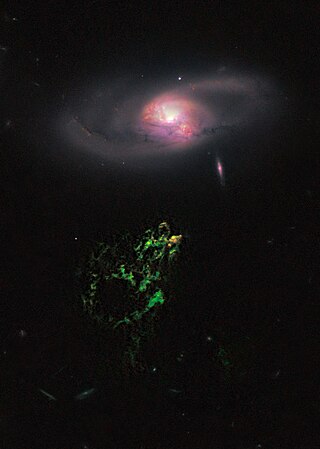
Hanny's Voorwerp is a type of astronomical object called a quasar ionization echo. It was discovered in 2007 by Dutch schoolteacher Hanny van Arkel while she was participating as a volunteer in the Galaxy Zoo project, part of the Zooniverse group of citizen science websites. Photographically, it appears as a bright blob close to spiral galaxy IC 2497 in the constellation Leo Minor.
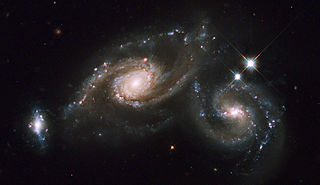
The NGC 5679 group, also known as Arp 274, is a triplet of galaxies, MCG+1-37-36, MCG+1-37-35 and MCG+1-37-34, spanning about 200000 light-years and at some 400 million light-years from Earth in the constellation Virgo. Arp 274 refers to the Atlas of Peculiar Galaxies, compiled by Halton Arp in 1966. Galaxies 269 through 274 in his catalogue are galaxies that appear to have connected arms.

Arp 147 is an interacting pair of ring galaxies. It lies 430 million to 440 million light years away in the constellation Cetus and does not appear to be part of any significant galaxy group. The system was originally discovered in 1893 by Stephane Javelle and is listed in the Atlas of Peculiar Galaxies.
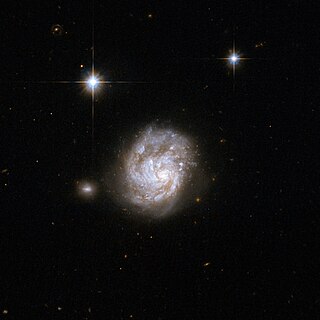
NGC 695 is a spiral galaxy located 450 million light years from the Earth, in the constellation of Aries. It has been described as an abnormal galaxy, and has the appearance of "a revolving tornado". Its arms are not tightly held together, and it is interacting with another small astronomical object. Despite its distance of nearly 0.5 billion lightyears, the galaxy's extremely luminous starburst disk, bright IR and UV emissions earned it a spot in the NGC catalogue. VLASS 1.2 survey images indicate the presence of extended radio emission in the core of the galaxy- indicative of either an active SMBH, nuclear starburst, or both.
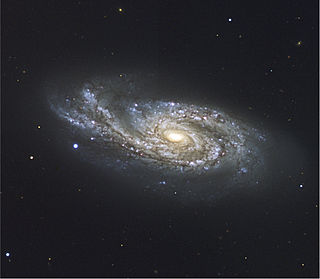
NGC 908 is an unbarred spiral galaxy in the constellation Cetus. It was discovered on 20 September 1786 by William Herschel. This galaxy is 56 million light years away from Earth. It is the main galaxy in the NGC 908 group, which also includes NGC 899, NGC 907, and IC 223.

IC 5332, also known as PGC 71775 is an intermediate spiral galaxy about 30 million light-years away in the constellation Sculptor. IC 5332 is not visible to the naked eye with an apparent magnitude of 10.72. Viewed from earth, it is nearly face on. It has a very small central bulge and open spiral arms accounting for its SABc classification. The galaxy lies in the direction of the galactic south pole.

NGC 226 is a spiral galaxy located approximately 216 million light-years from the Sun in the constellation Andromeda. It was discovered on December 21, 1786, by William Herschel.

NGC 1140 is an irregular galaxy in the southern constellation of Eridanus. Estimates made using the Tully–Fisher method put the galaxy at about 59 million light years. It was discovered on 22 November 1786 by William Herschel, and was described as "pretty bright, small, round, stellar" by John Louis Emil Dreyer, the compiler of the New General Catalogue.
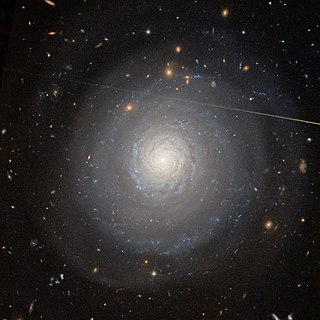
MCG +07-33-027 is an isolated spiral galaxy located about 330 million light-years away in the constellation Hercules. It has a very high rate of star formation which would make it a starburst galaxy. Normally, starburst galaxies are triggered by the collision of another galaxy. However most galaxies are in groups or clusters, while MCG +07-33-027 is solitary. Therefore, the cause of the starburst was not due to a collision or by the passing of a nearby galaxy and so the cause of the activity remains unknown.
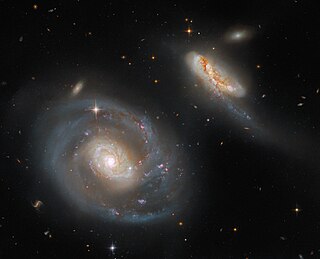
NGC 7469 is an intermediate spiral galaxy in the constellation of Pegasus. NGC 7469 is located about 200 million light-years away from Earth, which means, given its apparent dimensions, that NGC 7469 is approximately 90,000 light-years across. It was discovered by William Herschel on November 12, 1784.
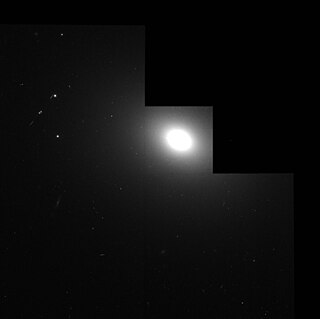
IC 1459 is an elliptical galaxy located in the constellation Grus. It is located at a distance of circa 85 million light-years from Earth, which, given its apparent dimensions, means that IC 1459 is about 130,000 light-years across. It was discovered by Edward Emerson Barnard in 1892.

IC 4687 known as IRAS 18093-5744 or F18093-5744, is an Sb spiral galaxy located in the constellation of Pavo. It is located 250 million light years from Earth and was discovered by Royal Harwood Frost on August 1, 1904, who described the object "as brighter middle with magnitude of 14. It has a surface brightness of 12.5.




















